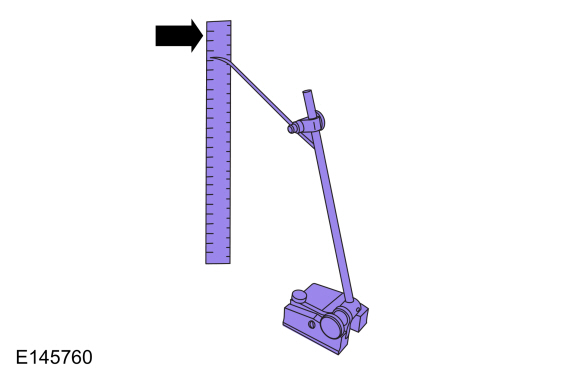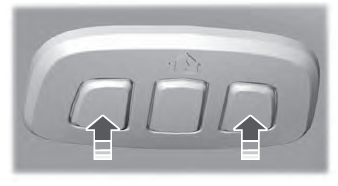Lincoln Nautilus: Suspension System - General Information / Ride Height Measurement. General Procedures
Lincoln Nautilus 2018-2025 Service Manual / Chassis / Suspension / Suspension System - General Information / Ride Height Measurement. General Procedures
Special Tool(s) / General Equipment
| Surface Gauge |
Check
Ride Height Measurement - Front
NOTE: Make sure that the vehicle is positioned on a flat, level surface and the tires are inflated to the correct pressure. Vehicle should have a full tank of fuel.
-
-
Ride height = 3-2
-
Measure the distance between the flat level
surface and the center of the lower arm forward bolt (measurement 2)
-
Measure the distance between the flat level
surface and the center of the ball joint pinch bolt (measurement 3)
Use the General Equipment: Surface Gauge
-
Ride height = 3-2
 |
-
With the surface gauge positioned on a flat, level
surface, record the measurement of the surface gauge position
(measurement 2) and (measurement 3).
Use the General Equipment: Surface Gauge
 |
-
Subtract measurement 2 from measurement 3 to obtain the front ride height.
Ride Height Measurement - Rear
NOTE: Make sure that the vehicle is positioned on a flat, level surface and the tires are inflated to the correct pressure. Vehicle should have a full tank of fuel.
-
-
Ride height = 3-2
-
Measurement 2
-
Measurement 3
Use the General Equipment: Surface Gauge
-
Ride height = 3-2
 |
-
Measure the distance between the flat level surface
and the center of the rearward lower arm-to-frame bolt (measurement 2).
-
Measure the distance between the flat level surface
and the center of the lower arm-to-knuckle bolt (measurement 3).
-
Subtract measurement 2 from measurement 3 to obtain the rear ride height.
 Rear Toe Adjustment. General Procedures
Rear Toe Adjustment. General Procedures
Special Tool(s) /
General Equipment
Wheel Alignment System
Adjustment
NOTICE:
Do not use any tools or equipment to move the wheel and tire
assembly or suspension components while checking for relative movement...
Other information:
Lincoln Nautilus 2018-2025 Service Manual: Roof Opening Panel Motor. Removal and Installation
Removal NOTE: Removal steps in this procedure may contain installation details. Place the roof opening panel glass in the fully CLOSE position. Place the roof opening panel shield to the fully OPEN position. Lower the headliner. Refer to: Headliner - Lowering (501-05) . Roof Opening Panel Motor - Glass ..
Lincoln Nautilus 2018-2025 Service Manual: Passive Anti-Theft System (PATS) - System Operation and Component Description. Description and Operation
System Operation System Diagram Item Description 1 IPC 2 Passive Key 3 RTM 4 GWM 5 GWM 6 PCM 7 PATS Center Antenna 8 Keyless Entry Rear Antenna 9 BJB 10 Door Handle Antennas 11 FCIM 12 Start/Stop Switch 13 Ignition Relay 14 BCM 15 PATS Enable Network Message Chart ..
Categories
- Manuals Home
- 1st Generation Nautilus Owners Manual
- 1st Generation Nautilus Service Manual
- Normal Scheduled Maintenance
- Locating the Pre-Collision Assist Sensors
- Power Outlet - Vehicles With: 110V Power Outlet
- New on site
- Most important about car
Clearing the Garage Door Opener. Reprogramming the Garage Door Opener. Garage Door Opener Radio Frequencies
Clearing the Garage Door Opener

Copyright © 2025 www.linautilus.com

